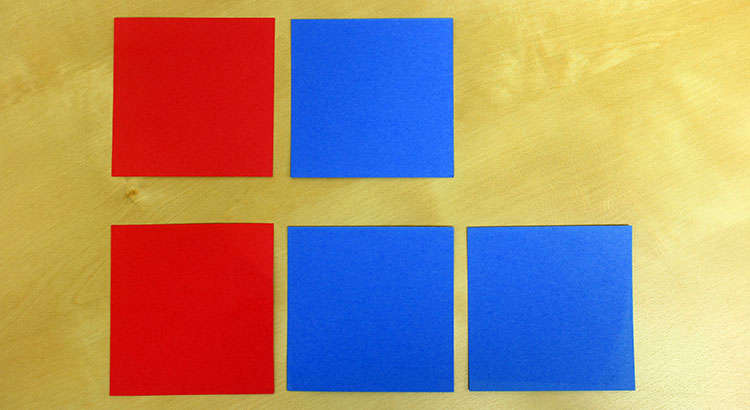C7: Introducing Words
1. Overview
Use colored paper squares to discuss how sentences are made up of individual words, introducing your child to a deeper awareness and understanding of the structure of sentences.
Top row: “Jane jumps.”
Bottom row: “Ann drinks milk.”
2. Materials
For this activity you will need two stacks of colored paper squares (for example, one stack of red squares and one stack of blue squares). A good size is 2 inches by 2 inches.- red squares = who it’s about words
- blue squares = what’s happening words
- Jane jumps.
- Beth runs.
- Tom laughs.
- Sam plays.
- Jane jumps high.
- Sam plays ball.
- Ann drinks milk.
- Bob eats peas.
- Jim rides bikes.
- Liz sits down.
- Joe talks fast.
- Kate reads books.
3. Activity
Video: How to play Introducing Words
Lay out one red square (who it’s about) and one blue square (what’s happening) to represent a two-word sentence with one-syllable words: for example, “Sam plays.” Explain to your child that this sentence has two parts, a who it’s about word and a what’s happening word.
Adult: Here is a sentence. Listen: “Sam plays.” You say the sentence. Child: Sam plays.Put down a red square as you say Sam and a blue square as you say plays. Speak very clearly, pausing between words. Point to each square as you say its word.
Adult: “Sam [put down card] plays [put down card].” “Sam [point to card] plays [point to card].” This sentence has two parts. Sam is the first part, and plays is the second part. Each part is called a word. Can you count each word? Child: One…two. Adult: You counted two words. Sentences are made up of words. What are sentences made up of? Child: Words. Adult: That’s right. We take words, and we put them together like this— “Sam [point to card] plays [point to card]”—to make a sentence. Can you say, “Sentences are made of words?” Child: Sentences are made of words.Now create a three-word sentence, using the same two words from the first sentence. Lay out the squares (one red and two blue squares) in a row below the squares for the first sentence. Line up the squares representing the first word of each sentence (as in the photo above) so it’s easy for the child to see which sentence is longer.
Adult: Here is another sentence. Listen: “Sam plays ball.” Again: “Sam [point to card] plays [point to card] ball [point to card].” Say the sentence. Child: Sam plays ball. Adult: Can you count the words in this sentence? Point to the words and count them. Child: One…two…three. [touches each word as he counts] Adult: Good. Tell me, is this sentence— “Sam [point to card] plays [point to card] ball [point to card]”— longer or shorter than this sentence— “Sam [point to card] plays [point to card]”? Child: I don’t know. Adult: How many words does this sentence have? [Point to the squares for “Sam plays ball.” Count with the child if necessary.] Child: One…two…three. Adult: And how many words does this sentence have? [Point to the squares for “Sam plays.”] Child: Two. Adult: The sentence with more words is longer. So, can you point to the longer sentence? Child: [pointing to the squares for “Sam plays ball”] That one! Adult: Good job finding the longer sentence!For the next round, have the child compare sentences made of totally different words, such as “Sam plays” and “Ann drinks milk.” Remove the squares you laid out for “Sam plays ball,” and put down three new squares (one red and two blue) as you say the words “Ann drinks milk.” Repeat this with at least five more sentences in a session. Mix it up so that sometimes the shorter sentence is first and sometimes the longer sentences is first. Review and practice this activity frequently in the upcoming days and weeks, until your child masters this new concept. It is a critical piece in building a child’s understanding of the structure of language. NOTE: Point out the spaces between the word cards. Explain that when you write words, you leave a little space to show where one word ends and the next one begins. NOTE: DO NOT write any words on the paper squares! This exercise is about learning to hear the individual words in a sentence. We are still a long way from reading! ↑ Top
4. Extension
Speak a sentence clearly, but without showing the corresponding paper squares. Ask the child to tell you how many words are in the sentence before you display the squares. ↑ Top5. Variation
Have the child give you a sentence verbally. Then have him place the corresponding paper square down to represent each word of his spoken sentence. Be sure that he leaves space between the squares. ↑ Top6. Small Groups (2-5 children)
Lesson Objective: Using paper squares as visual aids, children will count the number of words in short, spoken sentences and compare the lengths of sentence pairs. GELDS (Georgia Early Learning & Development Standards): CLL6.4d Additional Materials:- optional: small box tops, small trays, or placemats
Leave a Reply
